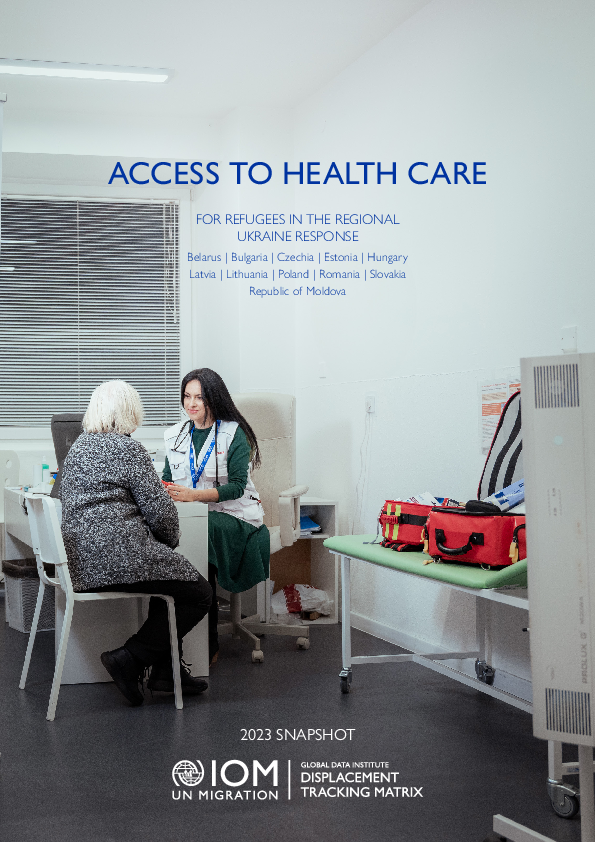-
Countries
-
Data and Analysis
-
Special Focus
-
Crisis Responses
Dashboard/Fact Sheet
Color
-
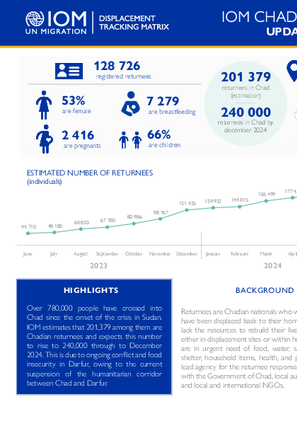
Contact
DTM Chad, dtmtchad@iom.int
Language
English
Location
Chad
Period Covered
Jun 18 2024
Jun 18 2024
Activity
- Mobility Tracking
- Event Tracking
Over 780,000 people have crossed into Chad since the onset of the crisis in Sudan. IOM estimates that 201,379 among them are Chadian returnees and expects this number to rise to 240,000 through to December 2024. This is due to ongoing conflict and food insecurity in Darfur, owing to the current suspension of the humanitarian corridor between Chad and Darfur.
Returnees are Chadian nationals who were living in Sudan and have been displaced back to their home country where they lack the resources to rebuild their lives. Returnees are living either in displacement sites or within host communities. They are in urgent need of food, water, sanitation and hygiene shelter, household items, health, and protection. IOM is the lead agency for the returnee response, in close coordination with the Government of Chad, local authorities, UN agencies, and local and international NGOs.
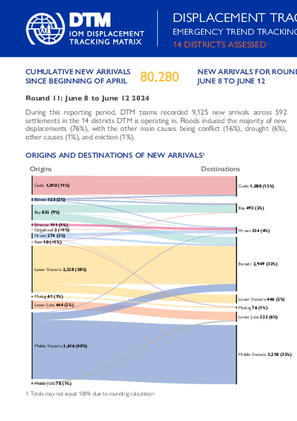
Contact
DTM Somalia, IOMSomaliaDTM@iom.int
Language
English
Location
Somalia
Period Covered
Jun 08 2024
Jun 12 2024
Activity
- Mobility Tracking
- Baseline Assessment
This latest round of Emergency Trends Tracking was initiated in April 2024 to monitor displacements movements during the Gu rainy season. Districts covered in this round include Afgooye, Afmadow, Baardheere, Baidoa, Balcad, Belet Weyne, Dayniile, Gaalkacyo, Hodan, Jamaame, Jowhar, Kahda, Kismaayo, Luuq. ETT is a crisis-based tool that tracks sudden displacement triggered by specific events or emerging crises.
The objective of ETT is to help prioritize humanitarian response and to enable partners to deliver rapid assistance. Based on previous shock induced displacement patterns, the humanitarian community expects that people will continue to move toward urban areas in search of humanitarian services. Consequently, the ETT coverage focuses on the main urban centers and surrounding villages for each assessed district. The data is collected through Key Informant Interviews (KIIs) at the location level, from Sunday to Wednesday every week. It includes information on new arrivals, numbers and demographic of IDPs, reasons for displacement, intentions, humanitarian assistance and priority needs among others.
The ETT tool also adapts to regional contexts: because of the very high number of IDP sites in Khada and Daynile districts in Banadir region and in Baidoa district in Bay region, a zonal approach has been adopted for these areas. Each week, KIIs are first conducted at the zone level to indicate to the field teams which locations have received the most new arrivals and which need to be assessed. To facilitate the joint analysis of the CCCM (Camp Coordination and Camp Management) Cluster’s New Arrivals Tracker (NAT) and ETT data, the assistance and needs indicators are identical in both tools.
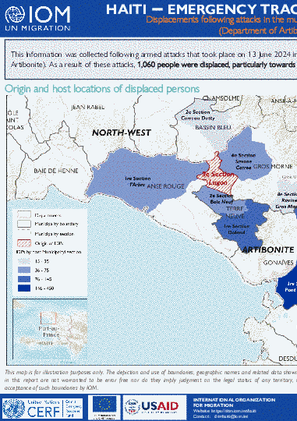
Contact
dtmhaiti@iom.int
Language
English
Location
Haiti
Period Covered
Jun 14 2024
Jun 17 2024
Activity
- Mobility Tracking
- Event Tracking
This Information was collected following armed attacks that took place on 13 June 2024 in the municipality section of Lagon located in the municipality of Terre Neuve (Department of Artibonite). As a result of these attacks, 1,060 people were displaced, particularly towards the municipality of Gonaïves (68%). All of these people took refuge with host families.

Contact
dtmhaiti@iom.int
Language
English
Location
Haiti
Period Covered
Jun 14 2024
Jun 15 2024
Activity
- Mobility Tracking
- Event Tracking
This information was collected following armed clashes that took place in the lower part of the municipality of Delmas in the Metropolitan Area of Port-au-Prince, since 13 June 2024.
As a result of these clashes, 767 people were displaced and the majority of them (67%) took refuge with host families in neighborhoods in the same municipality and in that of Port-au-Prince. The other 33% took refuge in two spontaneous sites where other displaced persons have been residing for several months. Updates will be published by DTM according to the
evolution of displacements.
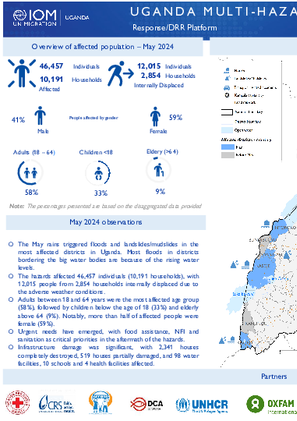
Contact
DTM Uganda, dtmuganda@iom.int
Language
English
Location
Uganda
Period Covered
May 01 2024
May 31 2024
Activity
- Mobility Tracking
The May rains triggered floods and landslides/mudslides in the most affected districts in Uganda. Most floods in districts bordering the big water bodies are because of the rising water levels. The hazards affected 46,457 individuals (10,191 households), with 12,015 people from 2,854 households internally displaced due to the adverse weather conditions. Adults between 18 and 64 years were the most affected age group (58%), followed by children below the age of 18 (33%) and elderly above 64 (9%). Notably, more than half of affected people were female (59%). Urgent needs have emerged, with food assistance, NFI and sanitation as critical priorities in the aftermath of the hazards.
Infrastructure damage was significant, with 2,341 houses completely destroyed, 519 houses partially damaged, and 98 water facilities, 10 schools and 4 health facilities affected.
It is important to note that the information presented in the dashboard is derived solely from the represented districts, and no other major hazard events were reported from other districts.
From January to December 2023, IOM’s Displacement Tracking Matrix (DTM) collected data on the Needs, Intentions, and Integration Challenges of refugees from Ukraine and Third-Country Nationals (TCNs) in 11 countries in the Ukraine Response: Belarus, Bulgaria, Czechia, Estonia, Hungary, Latvia, Lithuania, Poland, Republic of Moldova, Romania, and Slovakia. Over the course of 2023, a sample of a total of 28,712 respondents were surveyed on displacement patterns and experiences, including access and barriers to health care.
Key Findings
- One-third (34%) of respondents stayed with at least one person (including themselves) with a chronic condition.
- 16% of respondents had or accompanied someone with at least one disability in 2023.
- Across all 11 countries, 54% of the people interviewed faced one or more challenges to accessing health care.
- Top barriers included long waiting times (30%) and the language barrier (23%).
- Top health needs reported were health-care services (41%), medicines (29%) and psychological counselling (5%).
- 37% of households needed to pay for both health-care services and medicine.
- 42% of respondents needed more information on health-care services, 17% on psychological counselling and 12% on medicine.
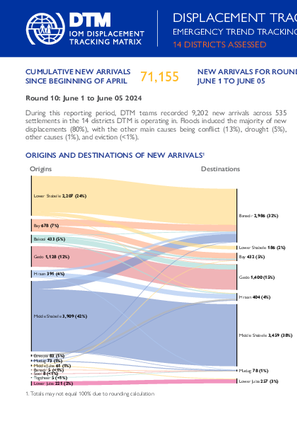
Contact
DTM Somalia, IOMSomaliaDTM@iom.int
Language
English
Location
Somalia
Period Covered
Jun 01 2024
Jun 05 2024
Activity
- Mobility Tracking
- Baseline Assessment
This latest round of Emergency Trends Tracking was initiated in April 2024 to monitor displacements movements during the Gu rainy season. Districts covered in this round include Afgooye, Afmadow, Baardheere, Baidoa, Balcad, Belet Weyne, Dayniile, Gaalkacyo, Hodan, Jamaame, Jowhar, Kahda, Kismaayo, Luuq.
ETT is a crisis-based tool that tracks sudden displacement triggered by specific events or emerging crises. The objective of ETT is to help prioritize humanitarian response and to enable partners to deliver rapid assistance. Based on previous shock induced displacement patterns, the humanitarian community expects that people will continue to move toward urban areas in search of humanitarian services. Consequently, the ETT coverage focuses on the main urban centers and surrounding villages for each assessed district. The data is collected through Key Informant Interviews (KIIs) at the location level, from Sunday to Wednesday every week. It includes information on new arrivals, numbers and demographic of IDPs, reasons for displacement, intentions, humanitarian assistance and priority needs among others.
The ETT tool also adapts to regional contexts: because of the very high number of IDP sites in Khada and Daynile districts in Banadir region and in Baidoa district in Bay region, a zonal approach has been adopted for these areas. Each week, KIIs are first conducted at the zone level to indicate to the field teams which locations have received the most new arrivals and which need to be assessed.
To facilitate the joint analysis of the CCCM (Camp Coordination and Camp Management) Cluster’s New Arrivals Tracker (NAT) and ETT data, the assistance and needs indicators are identical in both tools.
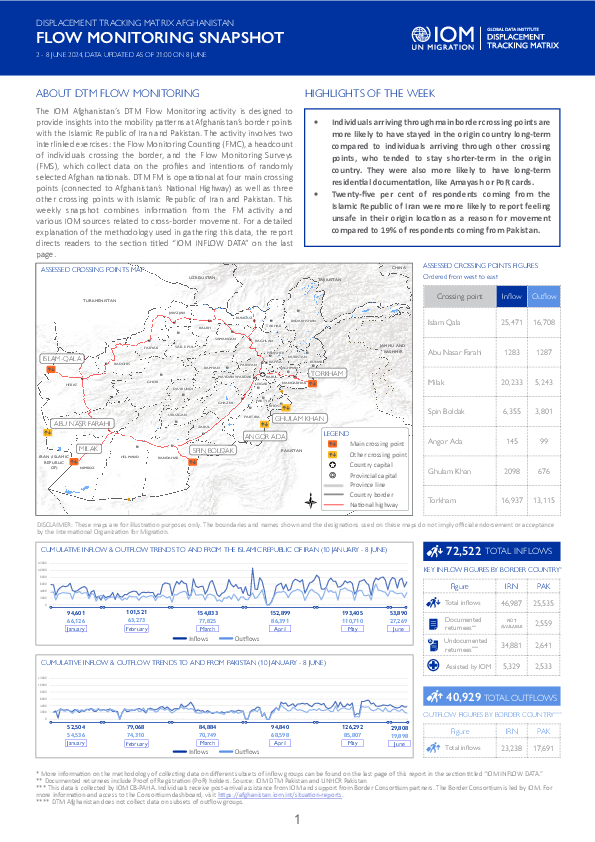
Contact
DTMAfghanistan@iom.int
Language
English
Location
Afghanistan
Period Covered
Jun 02 2024
Jun 08 2024
Activity
- Survey
- Flow Monitoring Survey
- Flow Monitoring
The IOM Afghanistan’s DTM Flow Monitoring activity is designed to provide insights into the mobility patterns at Afghanistan’s border points with the Islamic Republic of Iran and Pakistan. The activity involves two interlinked exercises: the Flow Monitoring Counting (FMC), a headcount of individuals crossing the border, and the Flow Monitoring Surveys (FMS), which collect data on the profiles and intentions of randomly selected Afghan nationals. DTM FM is operational at four main crossing points (connected to Afghanistan’s National Highway) as well as three other crossing points with Islamic Republic of Iran and Pakistan. This weekly snapshot combines information from the FM activity and various IOM sources related to cross-border movement. For a detailed explanation of the methodology used in gathering this data, the report directs readers to the section titled “IOM INFLOW DATA” on the last page.
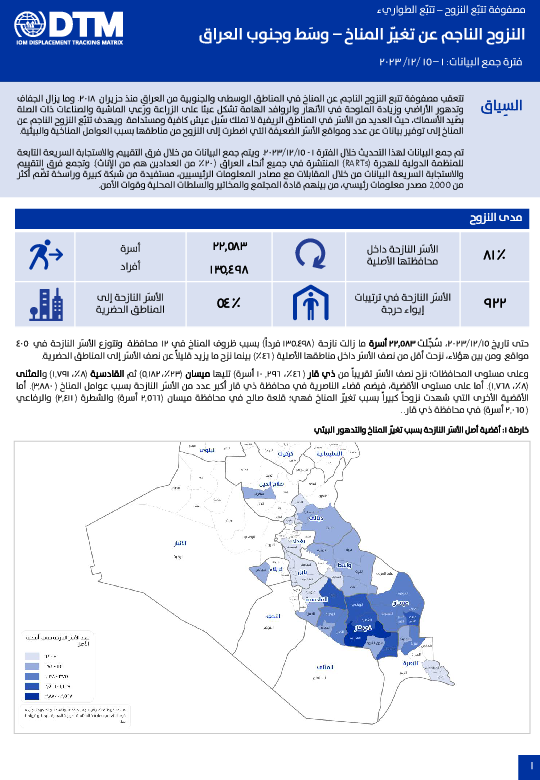
Contact
IraqDTM@iom.int
Language
English
Location
Iraq
Period Covered
Mar 01 2024
Mar 15 2024
Activity
- Mobility Tracking
- Event Tracking
يقيس تقرير تتبع حالات الطوارئ المناخية هذا (الترجمة العربية) النزوح الناجم عن المناخ في جميع أنحاء وسط وجنوب العراق. العائلات المشمولة في تقارير تتبع حالات الطوارئ هذه هي تلك التي أُجبرت على الانتقال من مواقعها بسبب الجفاف وندرة المياه والتدهور البيئي وعوامل مناخية أخرى.
وحتى 15 مارس/آذار 2024، لا تزال 23,364 عائلة (140,184 فرداً) نازحة بسبب العوامل المناخية في 12 محافظة. وتنتشر الأسر النازحة في 497 موقعًا. من بين هذه الأسر، أقل بقليل من نصف الأسر النازحة داخل منطقتهم الأصلية (47%). أكثر بقليل من نصف الأسر النازحة إلى مواقع حضرية.

Contact
DTM Iraq, IraqDTM@iom.int
Language
English
Location
Iraq
Period Covered
Dec 01 2023
Feb 29 2024
Activity
- Survey
- Flow Monitoring Survey
- Flow Monitoring
The Cross-Border Monitoring Report: Protection Risks and Concerns Among Travellers Crossing for Work data on labour-related protection risks among travellers passing through border crossing points monitored by IOM.
The main types of employment for incoming travellers were services, hospitality, and sales (29%); along with factory work (24%); Trained manual worker (15%) and unskilled manual labour (13%). For outgoing travellers, the main types of work were trained manual labour (36%); factory work (18%); Services, hospitality and sales workers (13%) and unskilled manual labour (6%).
The top protection concerns faced by these travellers were the provision of false information by employers regarding the nature of the work and working without receiving the expected payment.
Pagination
- Previous page
- Page 6
- Next page
